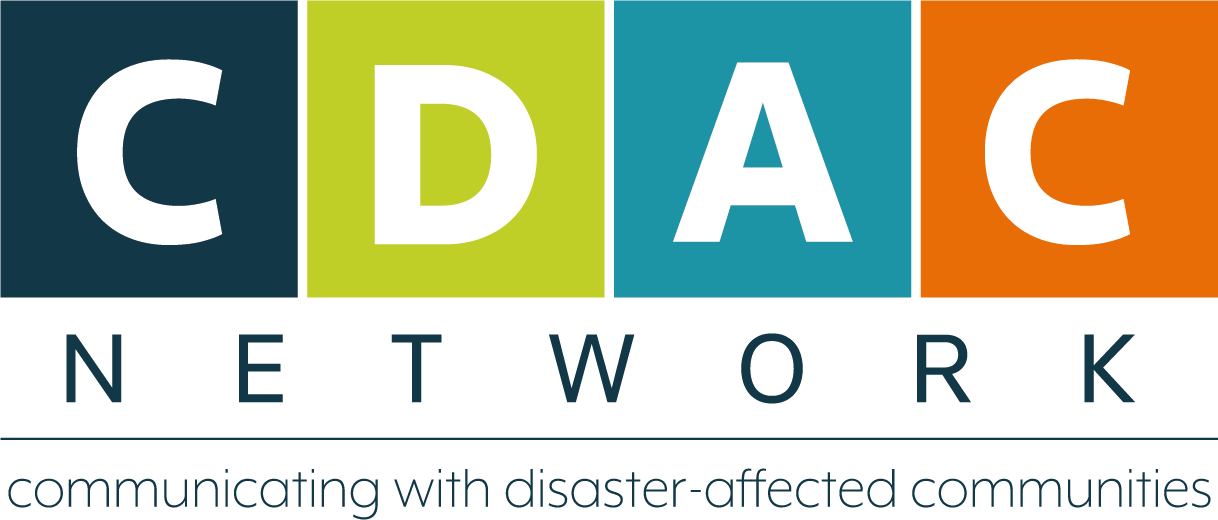Resources
Search our resources
Or filter resources by
Country/region
- Afghanistan 2
- Africa 32
- Americas 3
- Asia 11
- Bangladesh 3
- Belarus 1
- Burkina Faso 3
- Caribbean 7
- Chad 1
- Colombia 3
- Cote D'Ivoire 1
- DRC 1
- Dominica 2
- Ethiopia 3
- Europe 10
- Fiji 6
- Global 57
- Guinea 1
- Haiti 4
- Hati 1
- Horn of Africa 8
- Indonesia 1
- Iraq 1
- Kenya 10
- Libya 1
- Malawi 1
- Middle East 9
- Morocco 2
- Mozambique 4
- Myanmar 3
- Nepal 3
- Niger 2
- Pacific 19
- Pakistan 4
- Palestine 3
- Papua New Guinea 10
- Philippines 6
- Sierra Leone 1
- Somalia 3
- South Sudan 2
- Southeast Asia 7
- Sudan 6
- Syria 3
- Turkiye 3
- Ukraine 6
- Vanuatu 5
- Yemen 1
- Zimbabwe 1
Topic
- #safeai 3
- #safeaihumanitarianengagement 1
- #safeaiparticipation 3
- AI 7
- CDAC Public Forum 13
- COVID-19 12
- DEPP 7
- Digital security 2
- Ebola 1
- Lebanon 1
- Local Lifelines 3
- Myanmar 2
- National Platforms 9
- PSEA 2
- SMS 2
- Sudan 4
- accountability 47
- capacity bridging 15
- cholera 2
- climate 11
- co-design 3
- communication 110
- community engagement 80
- conflict 20
- coordination 51
- cyclone 3
- development 1
- digital 30
- digital hygine 1
- disability 2
- disaster 41
- displacement 14
- drought 3
- earthquake 14
- feedback 7
- financing 5
- floods 3
- harmful information 1
- health 16
- hotline 1
- hurricane 2
- inclusion 11
- information 70
- information integrity 8
- journalism 31
- localisation 28
- media 50
- media development 3
- misinformation 8
- needs assessment 7
Policy brief: The role of collective platforms to support communication and community engagement in humanitarian action
This independent review commissioned by CDAC Network confirms that the establishment of collective approaches to communication and community engagement – at national and global levels – is required to be more systematic and effective and has significant support across the humanitarian sector.
The role of collective platforms, services and tools to support communication and community engagement in humanitarian action
This independent review confirms that the establishment of collective approaches to communication and community engagement – at national and global levels – is required to be more systematic and effective and has significant support across the humanitarian sector.
Stepping up to the challenge of community engagement in a digital age: creating dialogue and ‘virtual safety nets’
Outcomes report from CDAC Network’s joint event with the ICRC and DFID in September 2016. The event brought considerable energy to a complex number of issues around communicating with people living in dire circumstances that must be resolved.
In Nepali: information and communication questions for needs assessments
As part of their support to the Nepal earthquake response, Translators without Borders translated 10 key questions on information and communication needs into Nepali.
Results-based protection and communicating with communities: summary and analysis
This paper summarises a webinar and online discussion held by the Interaction Results-Based Protection Programme and the CDAC Network on ‘Communicating with communities: analysing the role of information and the flow of communication with affected populations to address protection outcomes’.
Fanning the flame: the CDAC Network – a movement for change
This paper charts the story of the CDAC Network from the now infamous ‘pub meeting’ in New York in 2009 to the Network’s first Members’ Council in May 2014. It tells the story of the Network’s formative years: a time of forming and storming as the diverse membership set about building a movement for fundamental change in the way the humanitarian sector operates.
Communicating with communities and accountability: a current debate
This first working paper from CDAC Network explores what is understood by ‘communicating with communities’ (CwC) as an approach, and considers its relationship with accountability. It highlights the synergies and differences between the two concepts and proposes next steps for how the two concepts can coexist to benefit and strengthen humanitarian action.
Communication with communities during the first six weeks of an emergency
What are the minimum deliverables in a humanitarian response to meet a community's information and communication needs? This practice brief has been developed to describe the essential elements required to meet a community's information and communication needs during the first six weeks of a response.
Communication needs assessments
A comprehensive suite of common tools to assess the information and communication needs of communities affected by disasters, developed by CDAC Network members.
Emergency preparedness and response checklist for communication
This checklist contains a list of questions to help you be better prepared both before and after an emergency breaks
CDAC 101 Seminar reports
Key learning from expert seminars on humanitarian broadcasting; humanitarian financing; social media in emergencies; using SMS in humanitarian response; and mobile and humanitarian response.
TV feasibility assessment checklist
This checklist helps you to decide whether television is an appropriate channel of communication to use with crisis-affected populations.
Radio feasibility assessment checklist
This checklist helps you to decide whether radio is an appropriate channel of communication to use with crisis-affected populations.
Questions for information needs and access assessments
In the aftermath of an emergency, a rapid information needs and access assessment can cross check the community profile and provide a more accurate picture of the emerging needs on the ground. The questions can be inserted into an inter-agency needs assessment or done as a separate exercise.
Community profiling questions
Community profiles give you a good understanding of the community you are working with. They illustrate the community's socioeconomic characteristics, lifestyle and media consumption habits and can help inform your communication strategy.
CDAC Network simulation report
In October 2012, over 40 agencies across the humanitarian and media development sectors gathered to take part in the first CDAC Network simulation. The two-day crisis simulation aimed to build the capacity of staff within CDAC Network Member agencies and partners, to be prepared for and plan a coordinated, collaborative, multi-agency response to an emergency.
Infoasaid generic M&E framework
This framework allows you to assess the impact of communications interventions. Indicators cover key components of a communication project including: information provision, dialogue, analysis and verification of feedback and response.











